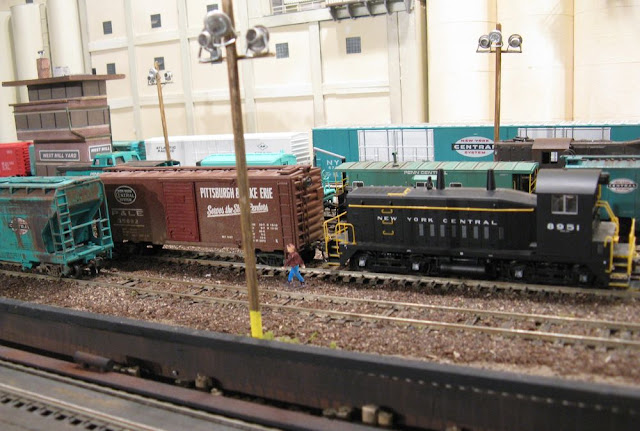Armed with their switch list, the intrepid crew of Switcher #8951 dives into their work and starts moving cars out of the way to access the ones they are looking for first. The cars will be blocked into sections that should make switching more convenient for the Terminal Yard crews.
They're just getting started and it ain't gonna be easy! Yardmaster Cappy Foster is unsympathetic. Its time to get the virtual ops up and running again!
First up is a block of cars for Bedford. These include a pair of 50 foot plug door cars that are empty for Universal Milling.
Coupled onto the plug door cars are two cars for Heilemans Brewery. The NYC Hi Cube is empty to receive cases of "long neck" bottles for Reynolds Beverage Distributors in Kings Port, while the B&M car is loaded with new bottles for Heilemans from Corning Glass.
Coupled together...
That completes the Bedford Block.
Next up is the East Bedford Block, including this Atlantic Pacific RR. RBL car loaded with windshields from Corning Glass, and an 86 foot NYC auto parts car from ACME Auto Parts, both for the Ford plant. They are coupled up with two NYC 50 footers from Peerless Appliance loaded with kitchen appliances for All City Storage.
This completes the East Bedford Block.
After that, the switcher crew assembles the East Empire City Block. This includes a PC gon loaded with steel coils for Gervais Pipe and Fittings for the manufacture of construction pipes...
....this TDLX Cargill covered hopper, empty for Cargill to receive barley for Cavendish Foods and Spirits to make their fine One Year Aged Scotch!!!....
...And, this empty Rock Island 50 footer which travels quite a bit between Ralph's Grocery Warehouse in East Empire City, NY and Ralph's Grocery Warehouse Midwest in Davenport, Iowa.
The RI car needs to be uncoupled from the P&LE car....
... so it can be placed with the other cars headed for East Empire City, completing the block.
Removing the Rock Island car fortunately expedites another move.
The switcher crew pushes the P&LE car (empty for Prestige Gear to load for Peerless Appliance) all the way to the end of the yard to retrieve a PC 40 ft. boxcar loaded with 55 gallon drums from KP Steel for Drywell Inks..
This two-car block for West Empire City is tacked onto the cut for WV-2.
Finally, these two empty TOFCs are for Terminal Yard while the two 38 ft. hoppers loaded with aggregate behind them are to be transferred to the L.I.R.R. for NY State DOT Region #10's highway project.
One end of the almost completely assembled cut of cars for WV-2 can be seen in the background with the B&M car and NYC Hi Cube.
The final block is coupled to the cut for WV-2.
An aerial view of the long cut of cars for WV-2 as seen from the North...
...and the South. The crew of switcher #8951 coasts down a cleared yard track to the right.
Next up: WV-2 arrives from Weehawken and picks up the cut from West Mill.





















































